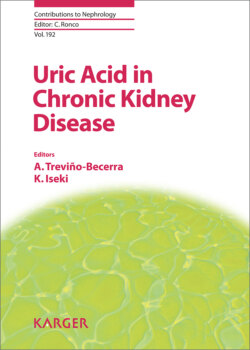Читать книгу Uric Acid in Chronic Kidney Disease - Группа авторов - Страница 35
На сайте Литреса книга снята с продажи.
Renal Hemodynamics in Hyperuricemia
ОглавлениеMicrovascular renal lesions are associated with the progression of renal damage by altering the autoregulatory response to blood pressure and/or by reducing the blood flow inducing ischemia [14]. Thus, the finding that HU caused afferent arteriolopathy led to the study on whether this lesion had functional implications. By using renal micropuncture techniques, it was found that oxonic acid-induced HU resulted in renal vasoconstriction with a significant increase in afferent and efferent resistances and reduction in single nephron plasma flow, single nephron glomerular filtration rate, and ultrafiltration coefficient (Kf) [15, 16]. An additional consequence of afferent arteriolopathy was the loss of autoregulatory capacity as was disclosed by the transmission of systemic hypertension to glomerular capillaries resulting in glomerular hypertension. Concomitant treatment with allopurinol to OA-treated rats prevented arteriolopathy and the alterations of renal hemodynamics. Moreover, significant positive correlations were found between the afferent arteriole wall area and serum uric acid, and glomerular pressure [15, 16]. It was also concluded that the blockade of the deleterious pathways induced by HU, such as the treatments with antioxidant or l-arginine, provided benefit, and therefore prevented the structural and renal hemodynamic changes induced by HU.
Renal hemodynamic alterations were also studied in 5/6 nephrectomy HU rats [16]. This model is characterized by systemic hypertension and increased renal blood perfusion and hyperfiltration due to a significant increase in glomerular pressure that results from the loss of the autoregulatory capacity in the afferent arteriole [14]. In this setting, HU produced profound renal vasoconstriction with a fall of 40% in single nephron glomerular filtration rate and Kf. There was also a higher proportional increase in afferent resistance than efferent resistance. Despite the intense preglomerular vasoconstriction, glomerular hypertension remained high, and renal damage was accelerated. Therefore, 5/6 nephrectomy rats had higher blood pressure, greater proteinuria, and inflammatory infiltration in comparison to the non-hyperuricemic group. Also, the concomitant treatment with allopurinol prevented the additional renal damage induced by HU in 5/6 nephrectomy rats [16].
In humans, it has been reported that HU is associated with renal microvascular damage, increased renal resistive index, afferent vasoconstriction in healthy subjects, CKD and hypertensive patients [17–19]. HU is also an independent predictor for the development of AKI in several clinical settings.
